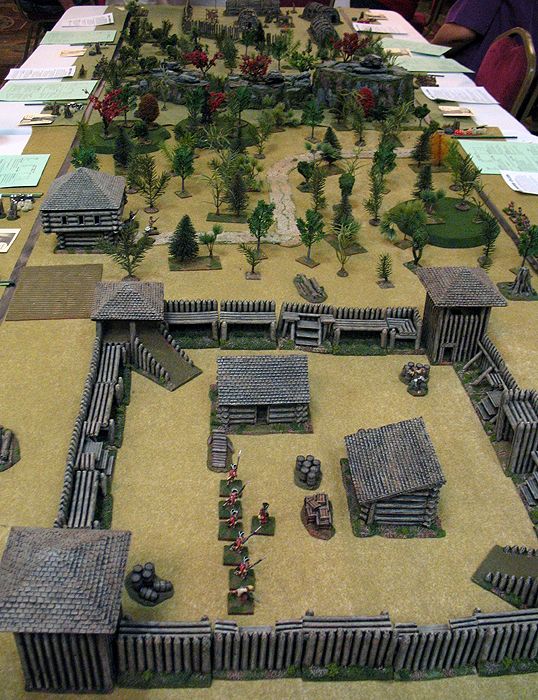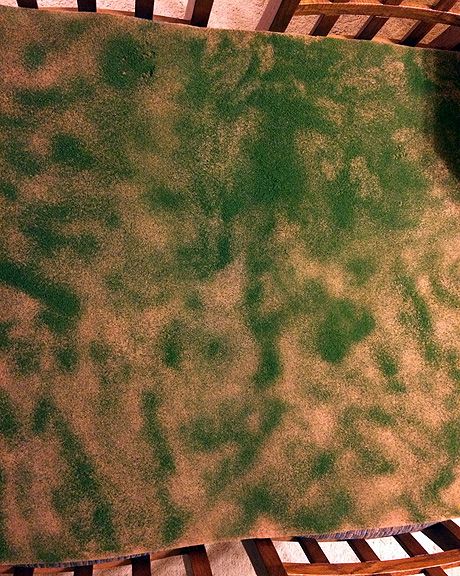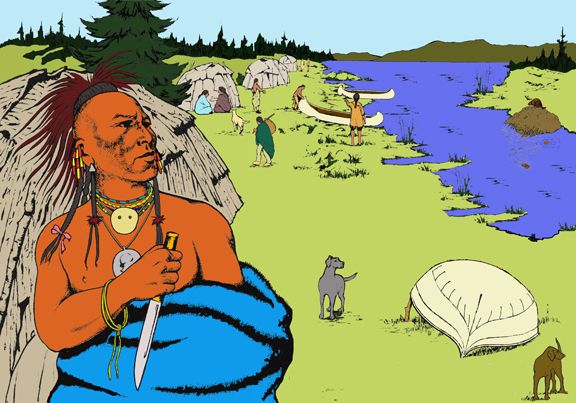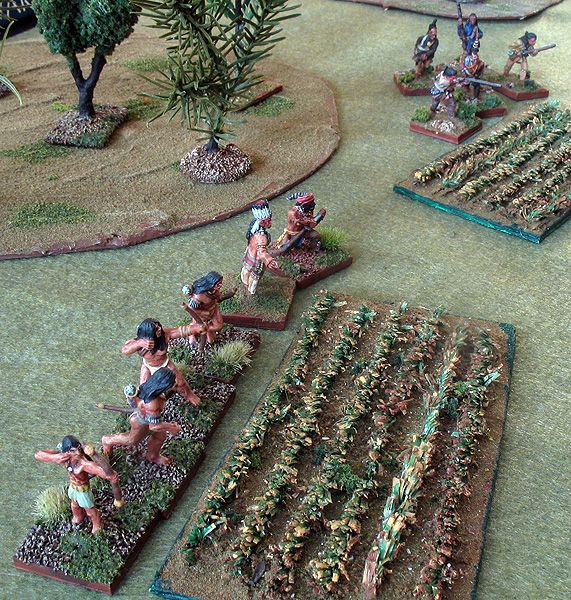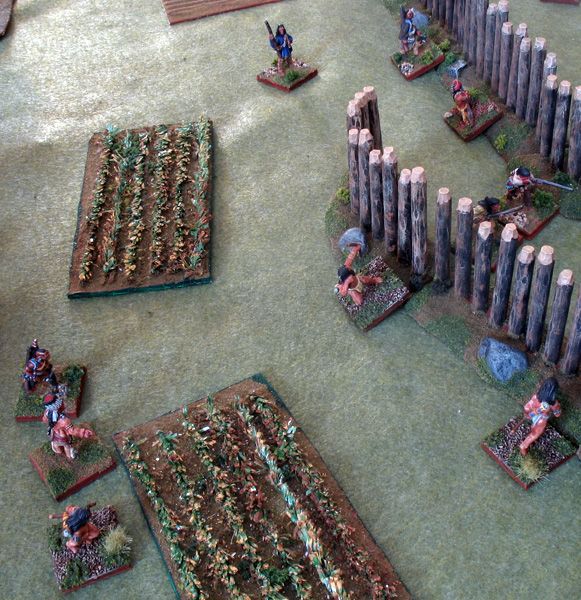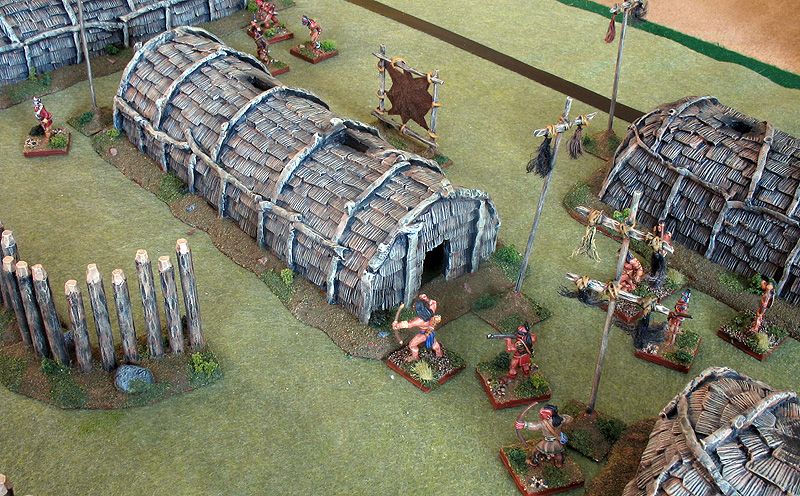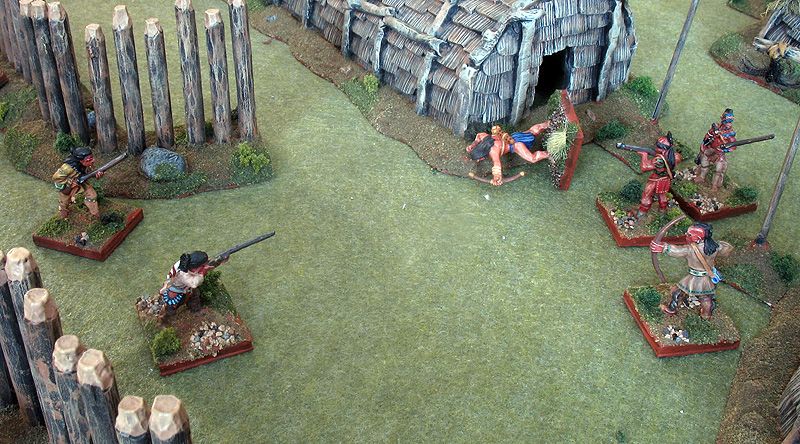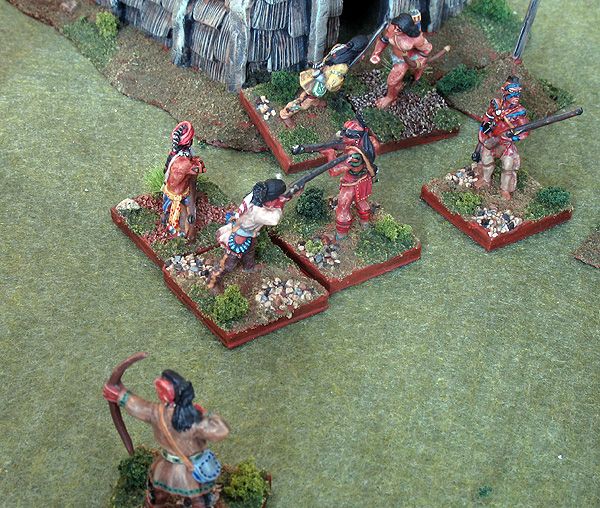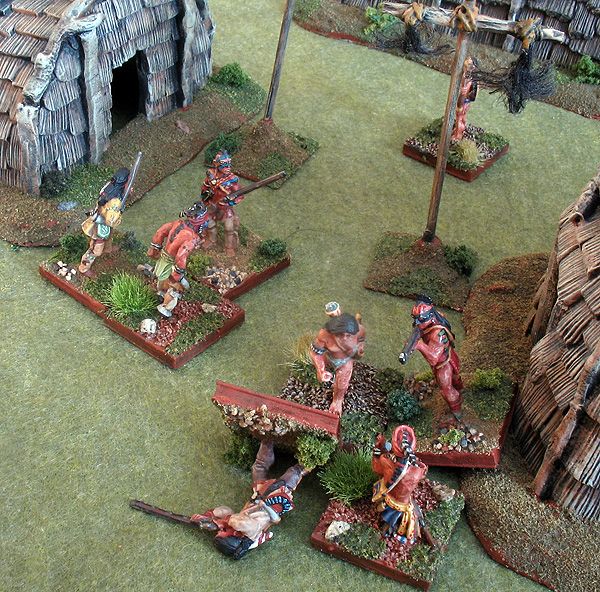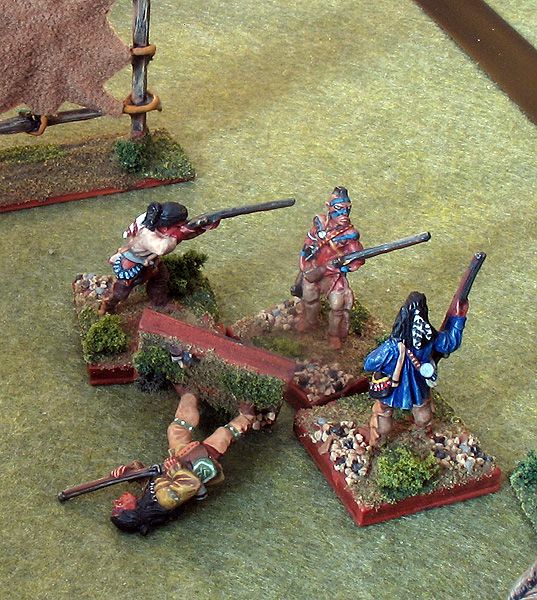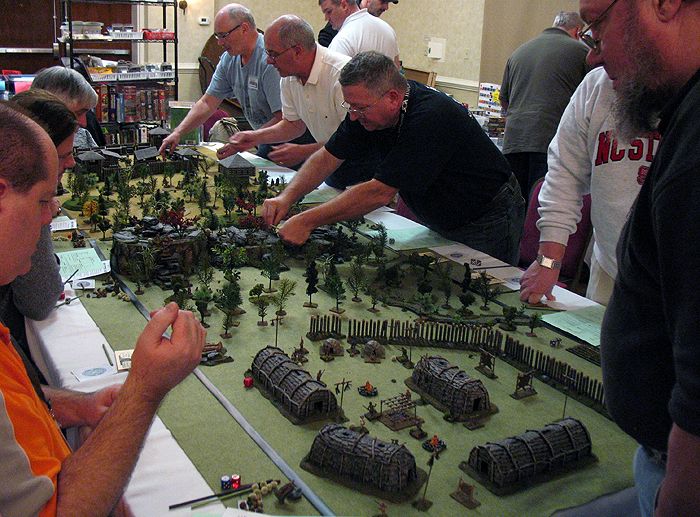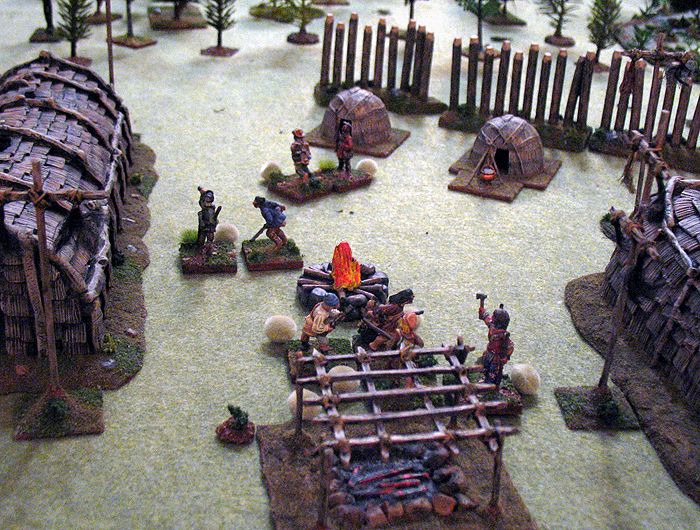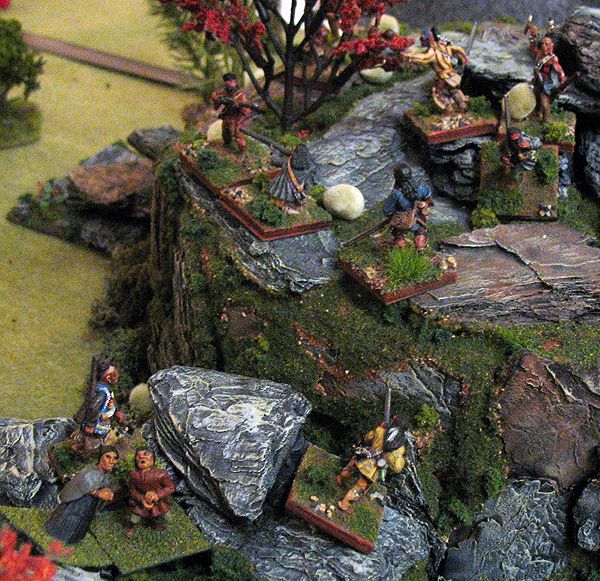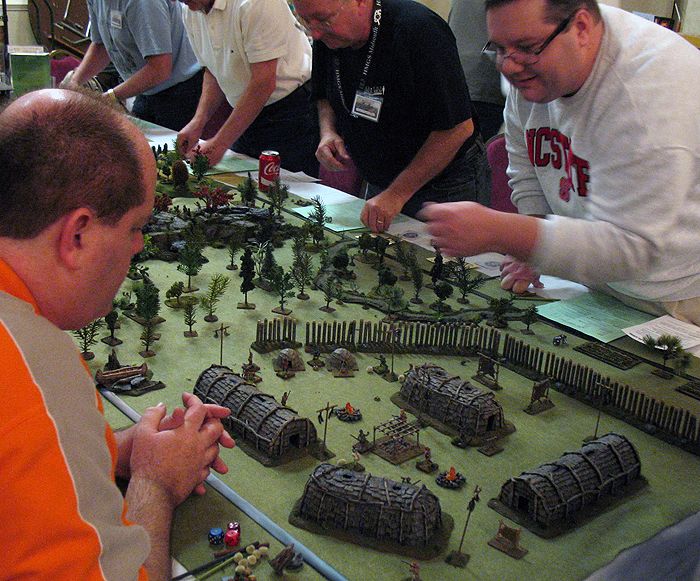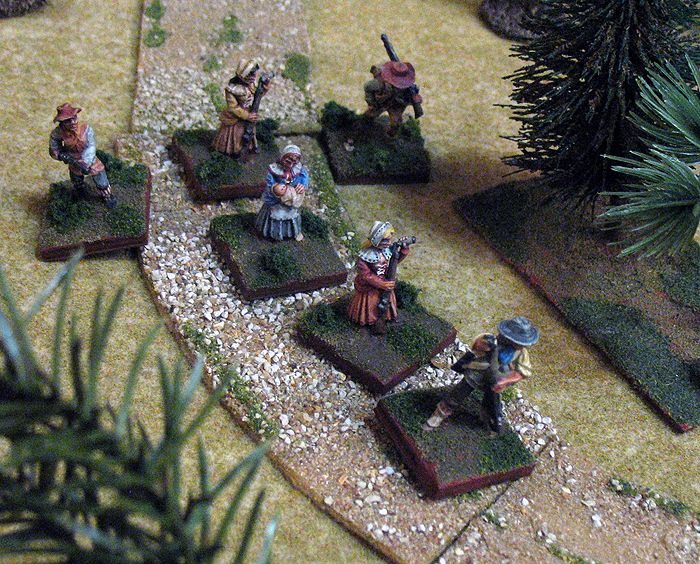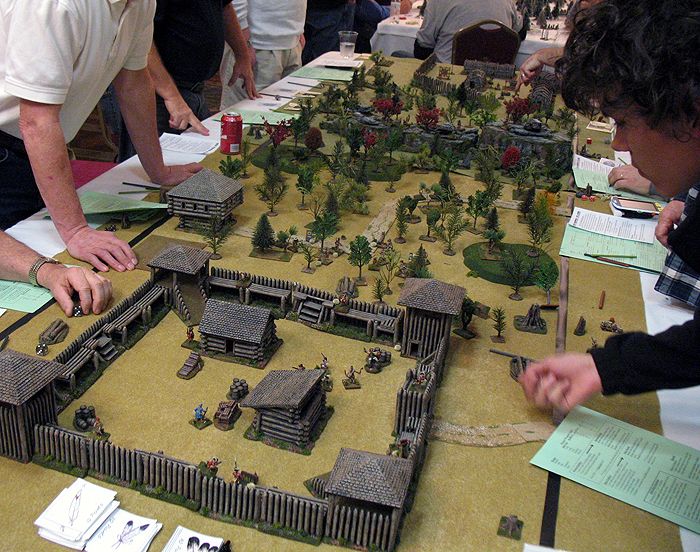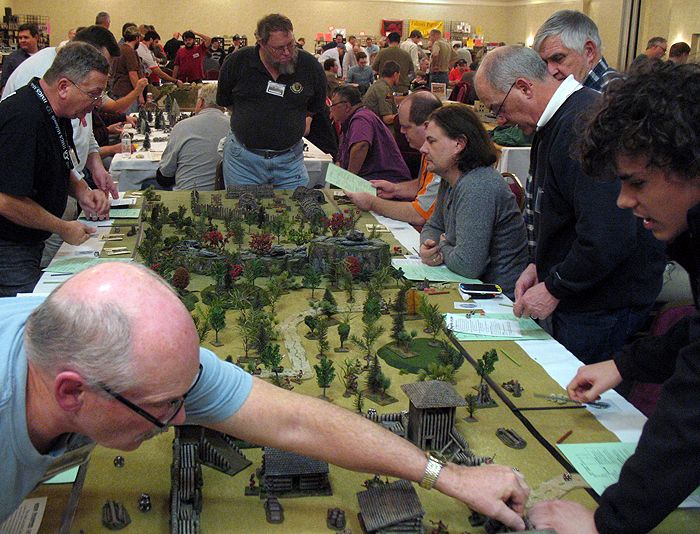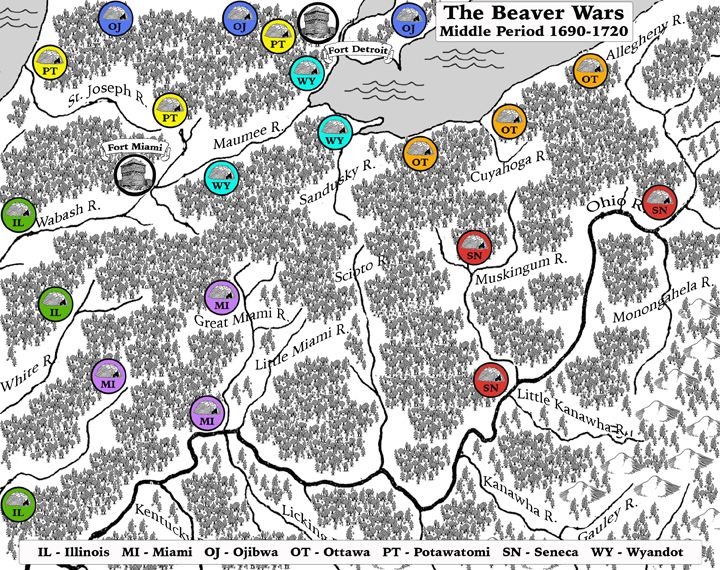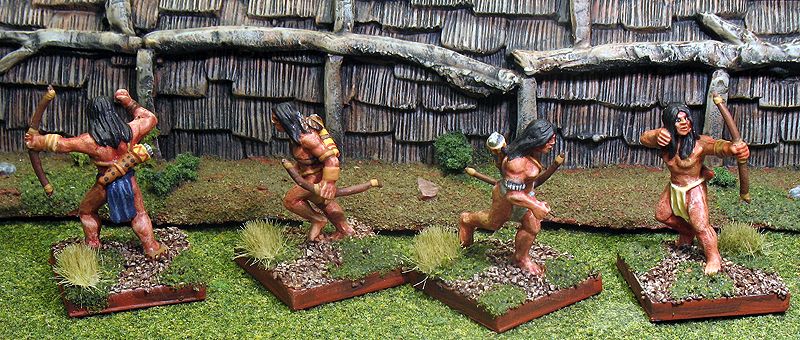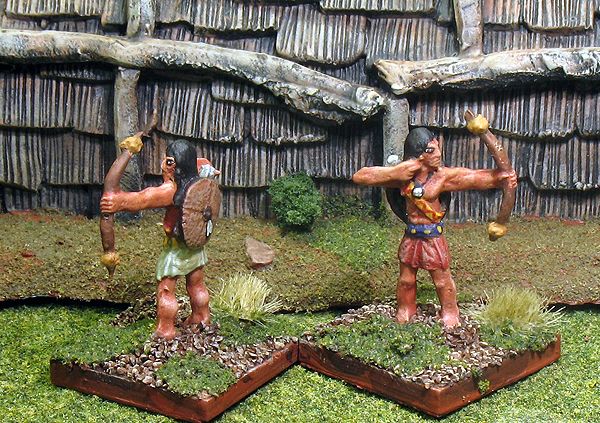This blog is intended to give you a look at how to play a campaign of
The Beaver Wars in Ohio. So, I'll be providing turn by turn reports, along with battle accounts, analysis of strategy (and tactics), and more. Some nasty winter ice coming in on our regular Sunday gaming session meant that only four of my six players were able to attend that night. The others sent in their orders, for the most part, so we were able to get Turn 1 under way.
I began the evening going through the rules and explaining them. They are written to be simple and easy to understand (what we hope will be a hallmark of
First Command Wargames products). One player had printed off a draft of the rules that I'd emailed everyone, and a second had read it online. The other two present were "winging it." They had no significant questions once I'd gone over the rules, though.
The Beaver Wars in Ohio is actually 3 campaigns in one, covering the warfare in the Ohio Valley from 1650-1750. I chose to run this first playtest using the middle campaign, 1690-1720. It features the following seven Indian tribes: Illinois, Miami, Ojibwa, Ottawa, Potawatomi, Seneca, and Wyandot. None of my players chose the Illinois tribe, so all their towns become "non-player" ones that the others may attack or ignore, as they choose.
The turn begins with the GM dealing out the cards which represent income and logistics in the campaign. This is a normal deck of 52 cards -- though, I have to admit I bought a special deck off of Amazon with a painting of a different Native American on each one. All tribes begin the campaign with a hand of 3 cards. Each turn, they receive cards according to the number of towns they control. I was playing the "Fair" version of the middle campaign, with all tribes starting out in control of 3 towns. So, each received 2 cards representing the income from their tribe's farming, hunting, trapping, and trading, thus beginning the game with a hand of 5 cards.

Next, players must establish the Turn Order. Each player chooses one of his cards in a bid for turn order. The higher the card, the sooner in the order their tribe chooses its action. This can become important because of the limitations on Invading or Raiding enemy tribes that have already been attacked. The Wyandot played the highest card, a Queen of Spades. He was followed by the Miami with a 9 of Spades, the Ottawa 6 of Hearts, Potawatomi 5 of Diamonds, Ojibwa 3 of Spades, and Seneca 2 of Hearts. There is a definite strategy to this phase of the campaign. Sometimes you want to declare your action earlier in the order, sometimes later in the order -- as the Miami were about to find out! These were the actions chosen:
- Wyandot initiated a Pow-wow (this allows players who attend the Pow-wow to trade cards)
- Miami chose to Visit the Trading Post (Keith got a lucky deal and already had a set of one of each suit, which would allow his tribe to turn in a bundle of Beaver Pelts and raise their Firearms Ratio)
- Ottawa chose to Ambush the Miami on their way to the trading post (if the ambushers catch the traders before they get there, and win the tabletop battle, they steal a card -- and Keith's set!)
- Potawatomi chose to join the Pow-wow
- Ojibwa chose to Trap & Hunt
- Seneca also chose to attend the Pow-wow
At the Pow-wow, players are free to trade whatever cards they have in their hands with other players who attend. This is an excellent way to create a set of one of each suit. The Wyandot and Seneca quickly struck a deal, trading one suit they had doubles of for one they were missing. Unfortunately for the Potawatomi, nobody wanted his Spades. This meant they went home empty-handed from the Pow-wow. In the future, I will probably give them the same option I give players who initiate a Pow-wow and have no one show up. They may look at the top card in the deck and trade it for one in their hand, if they choose. Think of this as minor, unrepresented tribes showing up to the Pow-wow. This is why play testing is important -- these type of things come to the front when your rules meet players (who tend to have minds of their own!).
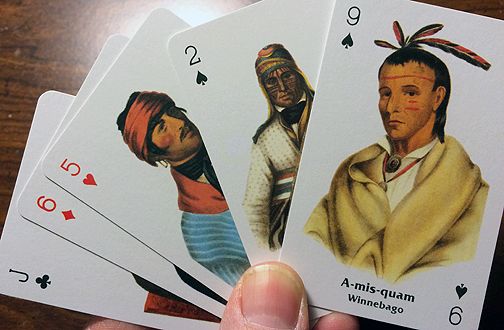 |
| Woo-hoo! The Miami player is dealt a set of one of each suit. He chooses the 'Visit Trading Post' action to cash in his bundles of Beaver pelts that sets represent. |
The Ojibwa player was one who could not attend that evening. So, I played his hand for his Trap & Hunt action. I turned up the top two cards of the deck and bingo! There was a suit that player needed. I made the swap and discarded the unwanted 2 cards.
That left this turn's battle to fight out. As the Attacker, the Ottawa rolled on the "Ambush vs. Visit to Trading Post" chart. The roll on the chart dictates which of the 6 possible scenarios would be used. Tom rolled a "5" -- which meant that the ambushing warparty arrived at the trading post
after the Miami. So, he set up his ambush just outside to catch them on their return. Tom set up the terrain according to the campaign rules for that scenario. Next, both players sat down and create troop lists.
One aspect of the Beaver Wars in Ohio is the honed-down army list players choose from. Essentially, they choose from 3 types of troops: chieftains (4 points), warriors (2 points), or youths (1 point). We were using the Small battle size, which awards each player 20 points to select their list from. An interesting feature of these rules is the "Firearms Ratio." This controls how common or rare muskets are among the tribe. Since we were playing the "Fair" version of the campaign, all tribes start out at 3:1. This means that a player must arm 3 figures with a Bow before giving one a Musket. Then, they must arm 3 more with Bow before receiving a second with a Musket. And so on. The Miami, on the other hand, had been fortunate. They began the game with a set, and were able to reach the trading post before the Ottawa ambush. This meant that the Miami armed his force using a 2:1 ratio, instead. Tom, who was playing the Ottawa, decided to offset the Miami advantage by choosing large numbers of Youths in his ambushing force. Larger numbers of Bow, mean correspondingly larger numbers of Muskets. Keith chose a smaller, more experienced force for his Miami trading party.
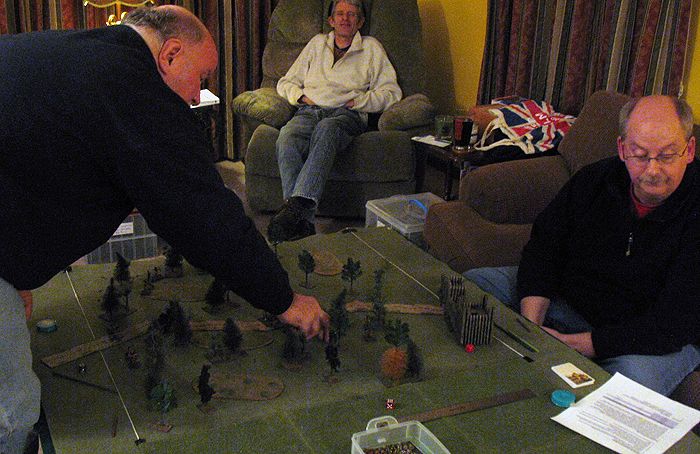 |
| Keith (Miami) on left and Tom (Ottawa) deploy their troops for the battle, while Joel (Potawatomi) Pow-wows... |
Ottawa Ambushing Force
1 Leader @ 4 points (Musket)
4 Warriors @8 points
(2 with Musket, 2 with Bow)
8 Youths @8 points (All with Bow)
-- as you can see, the wily Ottawa beefed up their numbers with Youths, allowing them to arm 3 of their figures with the much more deadly Muskets!
Miami Trading Party
1 Leader @4 points (Musket)
8 Warriors@16 points (2 with Musket, 6 with Bow)
-- The Miami were very efficient with their numbers, too. Since one of every 3 figures can be musket armed at the 2:1 ratio, building a force total of 9 figures maximized the amount of Musket-armed troops, while not sacrificing in quality.
 |
| Finished with their trading, the unsuspecting Miami trading party sets out on the trail |
The scenario called for the Miami to place their wagon containing their trade goods in the center of the 3'x3' table. The rest of the figures must be within 6" of that center point. He deployed in a couple of rows on either side of the wagon. The Ottawa chose to have a tree blocking the trail (which the scenario allows) and deployed a blocking force of one warrior and several youths across the trail. The rest of his force was deployed parallel to the trail. Both players nodded at Tom's use of the "Classic L-shaped Ambush," with Keith seeming particularly worried about the outcome for his Miami.
 |
| The Ottawa warparty included a large number of bow-armed Youths |
However, Tom quickly realized when the movement began that he should have placed his chieftain in a more central position.
In Song of Drums and Tomahawks rules, each figure has a Quality score. To activate the figure, you must equal or exceed its quality on 1d6 (with a +1 bonus if the Leader is within range). Youths have a Quality of only 5 -- as opposed to Warrior's 4 and Leader's 3. Most of the Ottawa Youths were outside of the command range of his chieftain, which would make moving them problematic.
On the other hand, Keith was looking at the ambush from an entirely different point of view. He saw the large numbers of Youths and was worried about his outnumbered warriors being swarmed. Much to my surprise, he began to abandon the wagon and exit off the nearest board edge. No Ottawa blocked their route, so their eventual escape was inevitable. The Ottawa tried to close, but had a hard time moving forward with the leader too far away to effectively urge all of his warparty on. One Ottawa killed a Miami who was guarding the front of the wagon with long range musket fire. As will be seen countless times this campaign (I'm sure), the jubilant warrior bolted forward towards his enemies to claim the scalp. The "Scalper" Trait in Song of Drums and Tomahawks required figures who have killed an enemy to make a Quality check to see if they "go out of control" and use all available movement to reach the spot of the slain enemy and spend an action scalping him. Miami muskets banged away at him and slightly wounded him, but he shrugged off the grazing hit.
 |
| The Ottawa blocking force, mostly bow-armed youths as well, did its job and discouraged the Miami from advancing upon them along the trail |
Anti-climatically, that was about it for the game. On the next turn, the Miami began to move off-board. Keith reasoned that his Firearms Ratio had been improved already, there was no need to die for the wagon's contents. I pointed out that they were valuable to the tribe -- tomahawks, copper kettles, European wares, etc. It also meant that none of his warriors gained any XP in this fight. Conversely, it meant that ALL of Tom's did. A figure receives 1 XP simply by staying alive and ontable by the end of the battle. They receive bonuses for scalps and for taking out enemy leaders.
I learned a valuable lesson in this first battle of the campaign: Players do not always see things like you do. Unless the rules actively discourage both sides from voluntarily runing away, and make significant penalties for those who do, players will take that as an option. I will rewrite the Ambush vs. Trading Post scenarios to reflect that Indians will not abandon their loaded wagon (or pack horses, as Keith suggested I change it to for more historical accuracy). The first turn excited the interest of the players, and provoked a lively email discussion. I expect the action to get even more heated on next turn.
 |
| Ottawa warriors advance upon the Miami traders, who quickly withdraw away from them and escape off-table. The wagon and many of its supplies that the warriors could not carry are abandoned to the ambushers. |
